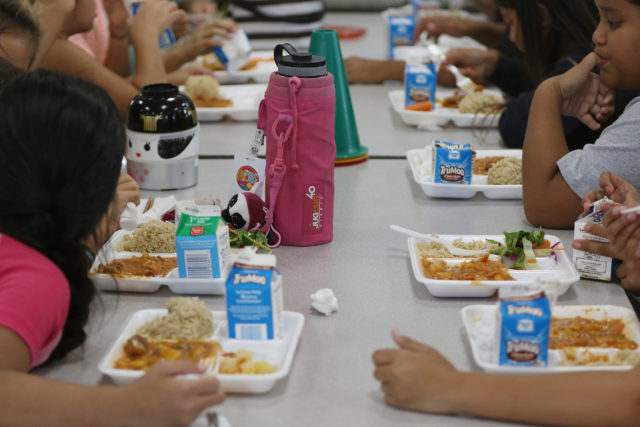Students in Lori Kwee鈥檚 fourth grade class at Ala Wai Elementary in Honolulu began a recent school garden lesson by discussing the meaning of 鈥渁ina,鈥� or land, segueing outdoors where they planted cuttings of uala, or sweet potato, then finally sampling the purple flesh of an Okinawan sweet potato.
The 10-year-olds raved about the food, served on green leaves. 鈥淚t tastes yummy.鈥� 鈥淚t looks like purple ice cream.鈥� 鈥淚t鈥檚 juicy.鈥�
The garden lesson 鈥� led by staff of the聽nonprofit聽聽鈥� put the kids in contact not just with the soil outdoors but the texture and taste of a food that was grown in it.
Educating students about agriculture, gardening and healthy eating are the goals of a farm-to-school movement in Hawaii that is expanding rapidly, mostly through the efforts of community groups and school leaders over the last decade.

Statewide, 83 percent of the 256 public, non-charter schools in the Department of Education have some form of school garden. These spaces are used for instructional learning, blended into topics like science, health, Hawaiian studies, even special education.
The push is part of a nationwide movement.
According to the by the United States Department of Agriculture, 42 percent of school districts across the U.S. participate in some farm-to-school activity, such as serving locally-produced meals in the cafeteria, while 44 percent of school districts said they had at least one edible school garden.
In Hawaii, the DOE currently does not allow any school garden produce to be brought into the school cafeteria and used in meals given USDA regulations.
But instructional school gardens nonetheless convey an , proponents say. Those include promoting healthy eating habits among children, upping physical activity, increasing awareness of STEM (science, technology, engineering, mathematics) concepts and ultimately enhancing academic achievement, according to the National Farm to School Network.
鈥淲hen you grow your own carrot, you eat it top to bottom,鈥� said Natalie McKinney, the executive director of Kokua Hawaii. 鈥淲e want the kids to be contributors to a healthy food system, to be able to want to eat fresh fruits and vegetables.鈥�
Community advocates here are prepared, with the cooperation of several agencies, to expand the footprint of the local farm-to-school movement. The聽, or coalition of groups, formed in 2010. In 2015, the state passed the聽聽which instituted a full-time Hawaii Farm to School coordinator position in the Hawaii Department of Agriculture.
It also launched a pilot program that brings made-from-scratch meals to the Kohala Complex area schools on the northern section of Hawaii Island.
Looking ahead, another pilot called the School Food Farm Pilot Project is set to move forward. Its goal is to develop a safety protocol that complies with USDA regulations that would allow school food programs to actually use the produce grown in school gardens for meals.

“We are working with DOE to start the first school food farm 鈥� to get food from the garden into the cafeteria for a long period of time,” said Robyn Pfahl, the farm-to-school coordinator who is spearheading the program.
Additionally, advocates plan to push for legislation in the new session to establish an official farm-to-school program in the Department of Education staffed with a full-time position and to establish a local food purchasing plan that offers more opportunities to connect local growers with state markets.
“With all the space they have on their school lands, the DOE has zero official policy for school gardens,” said Pfahl. “There鈥檚 a great number of things that need to shift before the DOE can come out and give official policy.”
‘Honest’ Learning
For now, school garden curricula are integrated into classrooms through groups like Kokua Hawaii, which offers monthly instruction to K-6 grade levels during the school year on things like planting food, tending a garden and expressing gratitude to the land.
At Ala Wai Elementary on a recent Monday, Kokua Hawaii volunteer Joe Wat led the fourth-graders in a chant as they planted tender sweet potato leaves.
鈥淚 hope you grow big roots. I鈥檓 going to take care of you so lead a happy life. I hope your leaves taste good,鈥� Wat recited for the students as they planted the uala into a garden bed outside a classroom.
Wat, who is also the garden and health coordinator at Kamaile Academy, a Hawaiian-focused arts integration charter school, tried to get the students to describe the soil as they dug a hole.
“Is it hot or cold?” he asked. “Is it crumbly or squishy? What’s it like? Any other adjectives?”
Kokua Hawaii has been sending representatives into Oahu elementary schools since 2006 to teach gardening concepts through the .聽On Oahu, 22 elementary schools, including Ala Wai, participate in the program.
Wat, who led the session with Summer Maunakea, a Ph.D. education student at the University of Hawaii Manoa, said he sees the benefits of the program up close.
鈥淲e鈥檝e gotten so far away from the things that sustain as humans,” he said. “In Hawaii, it鈥檚 more apparent than on the mainland, because our food comes from California.”
鈥淰ery rarely are our kids trusted to do something meaningful or impactful. This stuff is very honest. If you don’t take care of the plants, they鈥檒l die.鈥�
“Culturally Relevant” Meals
If the goal of instructional gardens is to eventually get youth to start eating more fruits and vegetables, incremental changes in Hawaii’s school meal plans due to new federal guidelines are also providing some support.

聽was ushered in during the Obama administration to encourage healthier eating. It required certain servings of fruits, vegetables and whole grains and capped the level of sodium, sugar and fat in school meals, including breakfast, lunch and snacks.
A recent visit to Ala Wai鈥檚 school cafeteria reflected those adjustments to new federal guidelines: lunch on a recent day consisted of beef stew, served with salad, brown rice and mixed fruit. (Kids eagerly scooped up spoonfuls of the stew, though the brown rice seemed more neglected.)
Even foods like pizza have moved in a healthier direction, according to principal Michelle DeBusca. Some versions are made with whole grain crust and could include vegetables as a topping.
Hawaii, which provides more than 100,000 lunches to students daily, has also moved to bring more local food into the schools through a new pilot program.
In 2015,听Hawaii Lieutenant Governor Shan Tsutsui launched a to incorporate more locally-grown food into school menus.
The pilot program is currently underway on Hawaii Island in partnership with聽, a community-based research center. School cafeteria staff prepare the made-from-scratch meals to students at Kohala Elementary, Kohala Intermediate and Kohala high schools.
Launched in January, the program features menus created by Greg Christian, a chef and founder of Beyond Green Sustainable Food Partners, and the cafeteria manager for those schools. The aim is to come up with lunches sourced from local farms and still pleasing to the palate for the hundreds of kids it serves.
For example, lunch items include Kalua pig with cabbage, local poi, pineapples, sweet potato, Pastele stew with Big Island beef and Big Island ulu salad with local apple banana.
鈥淩olling this out is not just changing the menu or buying a local tomato but teaching the cafeteria staff how to prep differently, how to rethink the customer,鈥� said Dexter Kishida, branch manager for DOE Food Services. 鈥淚t鈥檚 not just sending recipes to schools, it’s changing a culture (that) we’re used to: opening a box, re-heating to prepare meals.鈥�

According to Kishida, kids in the Kohala complex schools gravitate to certain items. The beef laulau plate was 鈥渙ne of the biggest hits on the menu,鈥� he said.
鈥淚t鈥檚 culturally relevant 鈥斅燼nd something the kids wanted,鈥� he said. 鈥淚 think that really resonated with them. It鈥檚 one of the plates where almost every ingredient on the plate can or was sourced locally.鈥�
The goal is to expand the Kohala Complex pilot to additional DOE schools this year, although those schools have not yet been announced.
Growth in Gardens
One segment of the DOE system that has been using locally-sourced food are the public charter schools. They have their own procurement policies that allows them to contract with local vendors and also incorporate school garden produce into meals.
For instance, at Ka’ohao School, formerly known as Lanakai Elementary, school leaders have partnered with One Love Cafe to deliver more healthful meals to kids. Lunch can consist of a chicken salad wrap, Kailua pig and cabbage with rice or roasted chicken.
鈥淚f you think of what you normally think of school lunch, it鈥檚 so much more fresh and tastier. It鈥檚 homemade,鈥� said Shawnna Wataoka, head of the School Lunch program at the school.
While the new U.S. Secretary of Agriculture, Sonny Perdue, some of the Obama-era restrictions around whole grains, sodium and milk fat in school meals, there are no plans at this time to revert Hawaii’s school meals back to those original levels, according to local school officials.
That’s welcome news to teachers, who say healthier school menus have had a noticeable effect on student attention spans.
鈥淭hey seem to have more energy,鈥� said Kwee, the fourth-grade teacher at Ala Wai. Her students get only 25 minutes of recess a day, broken up into one 15-minute period and another 10-minute period.

While Hawaii has developed 聽in conjunction with the 2010 Healthy, Hunger-Free Kids Act,听Hawaii still lags when it comes to the level of physical activity its kids receive.
The state’s 15 percent average rate of overweight high schoolers is 聽of 16 percent, but kids in Hawaii receive far less physical education time than the national average, according to 2015 statistics from Centers for Disease Control and Prevention.
That鈥檚 why proponents feel the school garden movement is a stepping stone to promoting healthier eating habits for Hawaii鈥檚 children, who have more sedentary lives than in years past.
The number of school gardens are on the rise statewide. In the 2011-12 school year, 74 percent of DOE schools reported having a garden, while 70 percent reported using that garden for instruction. By the 2015-16 school year, 87 percent of schools reported having a garden, with 83 percent using it for instruction.
In ideal conditions, the uala the Ala Wai fourth-graders planted recently will take up to four months to grow to its full potential, according to Wat. The kids will water the plant three times a day.
As the kids sampled the Okinawa sweet potato at the end of the morning session, they nodded their approval. Rare was a student among the class of 22 who found the taste unappetizing.
鈥淚t鈥檚 actually good,鈥� said Andres Jiminez, munching on the root vegetable.
 GET IN-DEPTH
REPORTING ON HAWAII鈥橲 BIGGEST ISSUES
GET IN-DEPTH
REPORTING ON HAWAII鈥橲 BIGGEST ISSUES
We need your help.
Unfortunately, being named a聽finalist for a聽Pulitzer prize聽doesn’t make us immune to financial pressures. The fact is,聽our revenue hasn鈥檛 kept pace with our need to grow,听.
Civil Beat is a nonprofit, reader-supported newsroom based in 贬补飞补颈驶颈. We鈥檙e looking to build a more resilient, diverse and deeply impactful media landscape, and聽we hope you鈥檒l help by .

